
Agave parryi, known as Parry's agave or mescal agave, is a flowering plant in the family Asparagaceae, subfamily Agavoideae. It is a slow-growing succulent perennial native to Arizona, New Mexico, and northern Mexico.

Lilium pardalinum, also known as the leopard lily or panther lily, is a flowering bulbous perennial plant in the lily family, native to Oregon, California, and Baja California. It usually grows in damp areas. Its range includes California chaparral and woodlands habitats and the Sierra Nevada.

Ceropegia woodii is a flowering plant in the dogbane family Apocynaceae, native to South Africa, Eswatini and Zimbabwe. It is sometimes treated as a subspecies of the related Ceropegia linearis, as C. linearis subsp. woodii. Common names include chain of hearts, collar of hearts, string of hearts, rosary vine, hearts-on-a-string, and sweetheart vine.

Allium moly, also known as yellow garlic, golden garlic and lily leek, Is a species of flowering plant in the genus Allium, which also includes the flowering and culinary onions and garlic. A bulbous herbaceous perennial from the Mediterranean, it is edible and also used as a medicinal and ornamental plant.
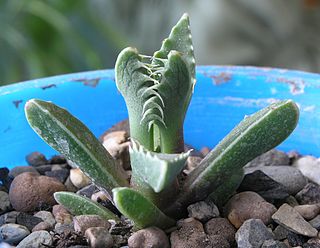
Faucaria is a genus of around 8 species of succulent subtropical flowering plants of the family Aizoaceae. The name comes from the Latin word fauces because of the appearance of "teeth" on the leaves.

Argyranthemum frutescens, known as Paris daisy, marguerite or marguerite daisy, is a perennial plant known for its flowers. It is native to the Canary Islands. Hybrids derived from this species are widely cultivated as ornamental plants in private gardens and public parks in many countries, and have naturalized in Italy and southern California. There are many cultivars, but the most common has white petals.

Mammillaria rhodantha, the rainbow pincushion, is a plant in the cactus family (Cactaceae) and is one of 171 species in the genus Mammillaria which are characterized by having nipple-shaped tubercles or prominences on their surface.

Sedum spathulifolium is a species of flowering plant in the family Crassulaceae known by the common names broadleaf stonecrop, yellow stonecrop, and spoon-leaved stonecrop. An evergreen perennial, it is native to western North America from British Columbia to southern California, where it can be found often in shade in many types of rocky habitat in coastal and inland hills and mountains.
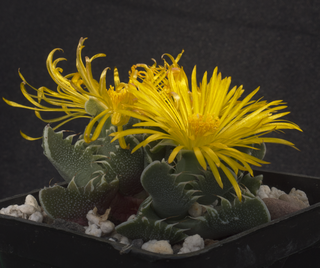
Faucaria tigrina, tiger jaws, is a species of succulent plant in the family Aizoaceae. It is endemic to South Africa, but also widely spread in cultivation. It has fleshy triangular leaves, a clumping habit, and blooms in autumn with yellow daisy-like flowers.

Thelocactus bicolor, the glory of Texas, is a species of flowering plant in the cactus family, widely distributed in the northern Chihuahuan Desert of the USA (Texas) and Mexico. Plants are usually solitary, but may form clumps. Growing to 50 cm (20 in) tall, it is a perennial with spiny, ribbed, succulent stems. Large daisy-like flowers, up to 8 cm (3.1 in) in diameter, are borne in summer. The petals are purplish-pink, fading to white. The inner petal tips form a circle of red surrounding a prominent yellow boss.

Lithops olivacea is a species of the genus Lithops under the family Aizoaceae. The name olivacea refers to the Latin word for olive (oliva) combined with the suffix -cea, meaning "of the likeness", producing the idea of "olive likeness". Lithops olivacea grow primarily in the Bushmandland of South Africa. They grow most abundantly in the regions of Aggeneys, Pofadder, and Namies. L. olivacea also received the Royal Horticultural Society's Award of Garden Merit for being "excellent for ordinary use in appropriate conditions, available to buy, of good constitution, essentially stable in form & colour, [and] reasonably resistant to pests & diseases."
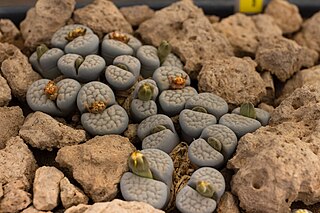
Lithops schwantesii is a succulent plant of the genus Lithops and a member of the family Aizoaceae. L. schwantesii receives its name from Gustav Schwantes, a prominent archaeologist and botanist of late 19th and 20th century. The succulent also received the Royal Horticultural Society's Award of Garden Merit for being a resilient and easy to cultivate plant.
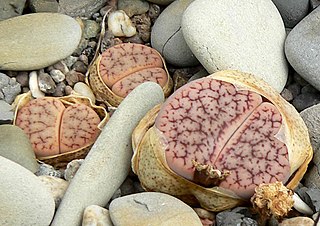
Lithops pseudotruncatella is a species of succulent in the family Aizoaceae. Initial confusion associated with Conophytum truncatum is where it derives its name, literally meaning "fake-truncatum". It also received The Royal Horticultural Society's Award of Garden Merit. The plant is endemic to Namibia.
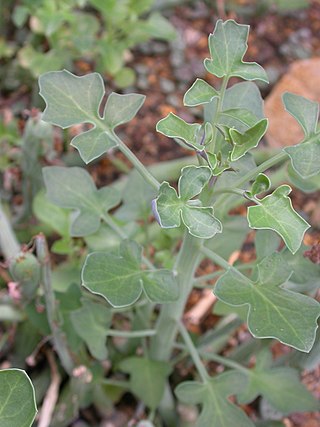
Curio articulatus, syn. Senecio articulatus, which is also known as candle plant, pickle plant and hot dog cactus, is a deciduous succulent plant that is native to South Africa.

Genista sagittalis, called the arrow-jointed broom and winged broom, is a species of flowering plant in the genus Genista, native to central and southern Europe, Ukraine, and Anatolia. Its subspecies Genista sagittalis subsp. delphinensis, called rock broom, has gained the Royal Horticultural Society's Award of Garden Merit.
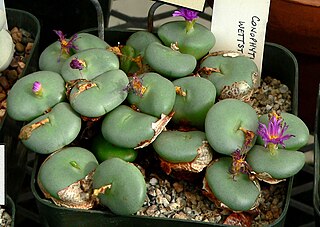
Conophytum wettsteinii is a species of flowering plant in the genus Conophytum, native to the northwest Cape Provinces of South Africa. It is known to grow in rocky regions, often nearby Crassula elegans. C. wettsteinii is a small groundcover species, which appears stemless with fused leaf-pairs having a obconical shape. This plant relies on winter rains and is mainly dormant in summer months. Best growth occurs when drainage is available, and when only shaded during mid-summer. PRopegation can occur through seeds or though cuttings from a full grown plant, where each cutting contains at least 1 head and a fraction of root. It has gained the Royal Horticultural Society's Award of Garden Merit.

Faucaria tuberculosa, called warty tiger jaws, is a species of flowering plant in the genus Faucaria, native to southern Cape Provinces of South Africa. A succulent, it has gained the Royal Horticultural Society's Award of Garden Merit.

Pleiospilos compactus, called living rock, is a species of flowering plant in the ice plant genus Pleiospilos, native to the southwestern Cape Provinces of South Africa. A succulent, it has gained the Royal Horticultural Society's Award of Garden Merit.

Huernia zebrina, the little owl, also called lifesaver cactus, is a species of flowering plant in the family Apocynaceae, native to Namibia, Botswana, northern South Africa, Zimbabwe, and Mozambique. A succulent, it has gained the Royal Horticultural Society's Award of Garden Merit.

Veronica incana, the silver speedwell, is a species of flowering plant in the family Plantaginaceae. It is native to parts of Eastern Europe and Russia, all of Siberia, Mongolia, and northern China, and has been introduced to Czechoslovakia. A number of authorities consider it to be a subspecies of the spiked speedwell Veronica spicata; Veronica spicata subsp. incana. It is a parent of the hybrids Veronica × czemalensis and Veronica × grisea.




















